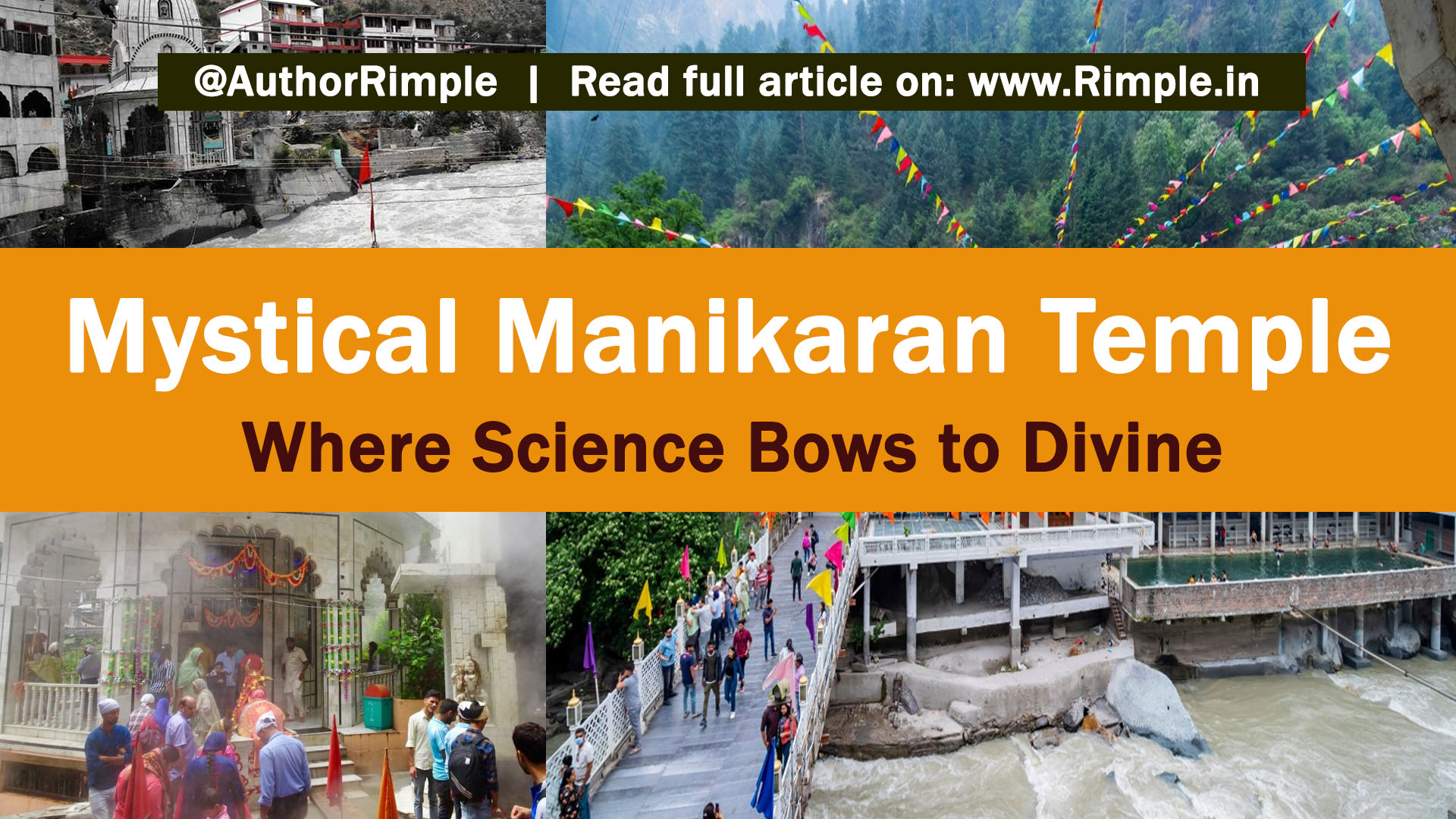Nestled in the heart of the breathtaking Parvati Valley in Himachal Pradesh, India, lies a sacred place where the divine seems to touch the earth in a way that leaves every visitor in awe—Manikaran. This small, serene town, cradled by towering Himalayan peaks and kissed by the wild, gushing Parvati River, is home to the mystical Manikaran Temple and Gurudwara, a divine sanctuary where science and spirituality dance together in perfect harmony. To step into Manikaran is to step into a realm where miracles feel real, where the air hums with sacred energy, and where every heart feels the whisper of the divine. India, the ancient land of gods and sages, truly comes alive here, proving that divinity doesn’t just reside in its stories but flows through its very soil.
A Land Blessed by Gods and Legends
Manikaran is no ordinary place. Its name, derived from the Sanskrit words Mani (jewel) and Karan (ear), tells a story that is as enchanting as the place itself. According to Hindu mythology, Lord Shiva, the cosmic destroyer and creator, and his divine consort, Goddess Parvati, once wandered through the lush, green valleys of this region. Captivated by its beauty—snow-capped mountains, emerald forests, and the playful Parvati River—they decided to stay here for not a day or a week, but an astonishing eleven hundred years. Imagine the love and serenity that must have filled this sacred land during their divine presence!
One day, as Goddess Parvati bathed in the crystal-clear waters of a stream, her precious jewel, a mani, slipped from her ear and vanished into the depths. Heartbroken, she turned to Lord Shiva, whose love for her knew no bounds. Determined to retrieve the lost jewel, Shiva commanded his attendants to search for it, but they returned empty-handed. In a moment of divine fury, Shiva opened his third eye—an act so powerful it could shake the universe. The cosmos trembled, and the serpent god Sheshnag, guardian of the underworld, was summoned to calm the chaos. With a mighty hiss, Sheshnag unleashed a torrent of boiling water from the earth, and along with it came not only Parvati’s lost mani but countless other sparkling jewels, as if the earth itself was offering its treasures to the divine couple. This miraculous event gave birth to the hot springs that make Manikaran so extraordinary, a place where the divine and the natural intertwine in a way that defies explanation.
For Sikhs, Manikaran holds another sacred tale. It is said that Guru Nanak, the revered founder of Sikhism, visited this holy land in 1574 with his disciple Bhai Mardana during his spiritual journeys. When they found no fire to cook their meal, Guru Nanak instructed his disciples to lift a stone. To their astonishment, boiling water bubbled forth from beneath, hot enough to cook their food. But the food kept sinking into the water, and so Guru Nanak taught them a lesson in faith and gratitude: “Offer the food to God, and it will float.” Miraculously, when they did, the food rose to the surface, perfectly cooked. This act of divine grace is why the Gurudwara in Manikaran is so sacred to Sikhs, a place where faith transforms the impossible into reality.
The Miracle of the Hot Springs
What makes Manikaran truly mystical is its hot springs, a phenomenon that feels like a gift from the gods themselves. Imagine standing on the banks of the icy-cold Parvati River, its waters rushing down from the Himalayan glaciers, and just a few steps away, steaming hot water gushes out from the earth, so hot it can cook rice in minutes! These springs, with temperatures ranging from 60 to 80 degrees Celsius, are not just a marvel of nature but a testament to the divine power that flows through Manikaran. The contrast is breathtaking: on one side, the freezing river roars with untamed energy, and on the other, scalding springs bubble with warmth, as if the earth is breathing life into the valley.
Devotees believe these hot springs have healing powers. A dip in the sacred waters, rich with minerals, is said to cure ailments like arthritis and soothe the soul, washing away sins and sorrows. At the Shiva Temple, you can see rice and grains being cooked in the boiling water as prasad (holy offering), a practice that feels like a miracle in itself. At the Gurudwara, the langar (community kitchen) prepares meals using these springs, serving thousands of pilgrims daily with food that carries the warmth of divine blessings. The steam rising from the springs blends with the crisp mountain air, creating an ethereal atmosphere that feels otherworldly, as if the gods themselves are present, watching over this sacred land.
A Place of Unity and Peace
Manikaran is a rare and beautiful example of harmony between faiths. The Shiva Temple and the Gurudwara Manikaran Sahib stand side by side, their sacred spaces blending seamlessly within the same complex. Hindus and Sikhs come together here, united by their devotion, proving that love for the divine transcends all boundaries. The temple, simple yet profound, houses idols of Shri Ram, Krishna, and Vishnu, while the Gurudwara’s prayer halls resonate with the soothing chants of Sikh hymns. The langar at the Gurudwara, open to all regardless of faith, caste, or creed, serves hot, delicious meals—rajma-chawal, kaddi, and rotis—that warm both the body and the soul. It’s a place where strangers become family, where every bite of food feels like a blessing from Guru Nanak himself.
The Naina Bhagwati Mandir, another gem in Manikaran, adds to the spiritual tapestry. Its architecture, with hints of Buddhist influence, tells the story of Goddess Naina Bhagwati, who emerged when Shiva opened his third eye. The temple’s serene beauty and intricate carvings draw devotees into a world of peace and reverence. Every corner of Manikaran feels alive with divinity, as if the gods have left their footprints in the stones, the water, and the very air you breathe.
A Journey to the Divine
Reaching Manikaran is like embarking on a pilgrimage to the heart of divinity. Located just 35 kilometers from Bhuntar and 4 kilometers from the vibrant town of Kasol, the journey is as beautiful as the destination. The road winds through the Parvati Valley, with the river dancing alongside and the mountains standing tall like silent guardians. Whether you arrive by bus from Bhuntar, a taxi from Kullu, or your own vehicle, the scenic route feels like a preparation for the spiritual experience that awaits. The nearest airport, Bhuntar, and railway station, Joginder Nagar, connect Manikaran to the rest of India, but it’s the journey through the Himalayas that truly sets the tone for this divine encounter.
As you cross the bridge into Manikaran, the bustling market greets you with the aroma of chai, momos, and gol-gappas. Small shops sell handwoven shawls and Nehru jackets, while a lone pastry shop tempts with fresh pizzas and burgers. But beyond the market’s charm lies the true treasure: the temples and Gurudwara, where time seems to stand still. The sound of the Parvati River, the steam from the hot springs, and the chants of prayers create a symphony that soothes the soul. Visitors often describe a sense of peace that washes over them, as if the chaos of the world melts away in the presence of the divine.
Why Manikaran Feels Like a Miracle
Manikaran is a place where science meets the divine in ways that leave you spellbound. How can boiling water spring from the earth next to a freezing river? How can a simple stone lifted by Guru Nanak create a miracle that feeds thousands? These are mysteries that science cannot fully explain, and perhaps it doesn’t need to. In India, a land where divinity is woven into every mountain, river, and temple, Manikaran stands as a shining example of the sacred mysteries that make this country so extraordinary. The hot springs, the legends of Shiva and Parvati, the miracles of Guru Nanak—these are not just stories but living truths that pulse through the heart of Manikaran.
Every visitor, whether a devout pilgrim or a curious traveler, leaves Manikaran with a sense of wonder. The beauty of the Himalayas, the warmth of the hot springs, the unity of faiths, and the stories of gods and gurus create an experience that is nothing short of magical. India is indeed a land where divinity resides, where every stone and stream carries a story of the divine. Manikaran is a reminder that in this ancient land, the gods are not just in the heavens but walk among us, their presence felt in every ripple of water and every whisper of the wind.
A Call to Experience the Divine
If you ever find yourself longing for a place where the heart feels full, where the soul feels cleansed, and where the mysteries of the divine unfold before your eyes, make your way to Manikaran. Stand by the hot springs and feel the earth’s warmth. Offer a prayer at the Shiva Temple and feel Shiva’s strength. Sit in the Gurudwara’s langar and taste the love in every bite. Walk through the Parvati Valley and let the mountains remind you of the grandeur of creation. Manikaran is not just a destination; it is a journey into the heart of divinity, a place where India’s spiritual legacy shines brighter than ever.
In Manikaran, you don’t just visit a temple or a Gurudwara—you step into a world where science bows to the divine, where miracles feel as natural as the flowing river, and where every moment reminds you that India is, and always will be, a land where the gods live and breathe. Come, experience Manikaran, and let your heart proclaim, “Wow, India is truly a land where divinity originates!”
Such Miracles HAPPEN ONLY IN INDIA.
Videos:
Rice cooked in hot springs.
People are cooking their own lentils in the hot water of Manikaran Temple.
IT HAPPENS ONLY IN INDIA
Also Read:




